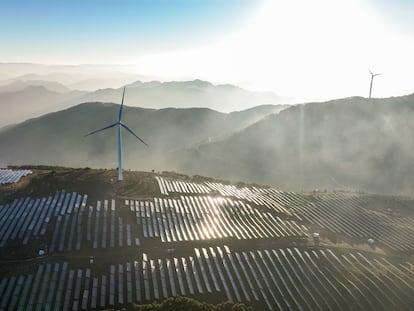Bitcoin mining uses the same amount of energy as Argentina, while laptops need a ton of material
The United Nations has released a new report warning of the environmental impact of digitalization. ‘Tech companies are monetizing the Anthropocene,’ argues one expert
Digitalization leaves a mark, even if it is invisible. To manufacture a typical laptop weighing 4.4 pounds, almost a ton of materials is needed, about 1,760 pounds. The extraction of these resources leaves an even bigger footprint. For example: two million liters of water are needed to extract one ton of lithium, the basic material for today’s batteries. And then there are the other activities linked to these products. For example, global energy consumption of bitcoin mining increased 34-fold between 2015 and 2023, reaching 121 terra-watt hours (TWh) of energy annually — the equivalent of what is consumed by a country like Argentina. That’s according to the U.N. Trade and Development (UNCTAD) experts, which warns of these issues in its Digital Economy Report 2024.
The trail left by an airplane is a small, perceptible sample of the pollution generated by air traffic. But digitalization does not leave smoke, and its effects are less evident. However, according to the UNCTAD report, the information and communications technology sector’s carbon footprint accounted for 1.5 to 3.2% of global greenhouse gas emissions.
If all the world’s digital information were stored on stacked compact discs, the tower would reach beyond the Moon, according to a study published in Science. In 2022 data centers — which transport, store and process this huge amount of global information — consumed 460 TWh of electricity, almost double the consumption of a country like Spain. And this figure is expected to double by 2026.
Another problem is the extraction of critical minerals, such as graphite, lithium and cobalt — which is expected to increase by 500% in 25 years — or physical waste from digitalization, which grew by 30% in the last decade. Developed countries generate on average 3.25 kilograms of waste per person, compared to 1 kg and 0.21 kg in developing countries. Of all this digitalization-related waste, not even 24% is formally collected.
The report blames the rise in e-waste to growing digitalization, which has led the production of semiconductors to quadruple; the push for more devices, which are expected to number 39 billion by 2029; and the rise of e-commerce, which saw $27 trillion in business sales in 43 countries in 2022.
This reality, according to António Guterres, Secretary-General of the United Nations, “highlights the direct environmental impact of our increased reliance on digital tools – from raw material depletion, water and energy use, air quality, pollution, and waste generation. These are accentuated by emerging technologies such as artificial intelligence and the internet of things.”
Rebeca Grynspan, head of UNCTAD, agrees: “The digital economy, often praised for its virtual and intangible nature, has created the illusion of a world unburdened by material waste. However, this Digital Economy Report 2024 starkly reveals the fallacy of this perception.”
However, Grynspan argues that digitialization “also holds immense potential for environmental good. Digital technologies can drive energy efficiency, optimize resource use and enable innovative solutions for climate change mitigation and adaptation.”
“We must harness the power of digitalization to advance inclusive and sustainable development, while mitigating its negative environmental impacts. This requires a shift towards a circular digital economy, characterized by responsible consumption and production, renewable energy use and comprehensive e-waste management.,” she says in the foreword to the report.
Water exploitation
“The United Nations report highlights that, although digitalization is driving global economic growth and offers unique opportunities, for developing countries, it is causing environmental repercussions that are increasingly serious and increasingly grave,” says Pablo Gámez Cersosimo, a Costa Rican advisor based in the Netherlands, where he heads Naturally Digital, an organization specializing in sustainability, human behavior, ethics and digital well-being.
Gámez — who has worked as a researcher and consultant for UNCTAD — says the study identifies how, in addition to the carbon footprint, digitalization requires large amounts of water, which he believes is one of “the most complex and problematic problems.”
"I would venture to say that the sum total of water consumed by all the agents involved in the operation of the digital wheel, so to speak, could equal or exceed that of the chemical or textile industry in the world," he says.
Water is needed in all phases of the digitalization cycle: in device manufacture, in operating data centers, in keeping artificial intelligence active and in the creation of semiconductors.
Gámez explains that “the projected consumption per person per year of water in Europe will increase from 0.29 cubic meters to 1.2 in 2030” — quadruple today’s figure. “This means that any European will use approximately three liters of water per day for internet activities, and this exceeds the usual amount needed,” he explains.
The researcher wants technology companies to be more transparent, arguing they prevent oversight, monitoring and the application of corrective measures. “Cyberspace has a limit with respect to the planet’s natural resources; it is completely dependent on mining, on the entire periodic table. The large multinationals know this, but they are not acting sufficiently to correct it, despite the solutions from the point of view of technological maturity,” he says. “These large technology corporations are profiting, they are monetizing the Anthropocene [geological epoch marked by the global impact of human activities].”
“Cyberspace is literally the largest infrastructure created by humans, and it doesn’t stop growing,” he concludes.
Sign up for our weekly newsletter to get more English-language news coverage from EL PAÍS USA Edition
Tu suscripción se está usando en otro dispositivo
¿Quieres añadir otro usuario a tu suscripción?
Si continúas leyendo en este dispositivo, no se podrá leer en el otro.
FlechaTu suscripción se está usando en otro dispositivo y solo puedes acceder a EL PAÍS desde un dispositivo a la vez.
Si quieres compartir tu cuenta, cambia tu suscripción a la modalidad Premium, así podrás añadir otro usuario. Cada uno accederá con su propia cuenta de email, lo que os permitirá personalizar vuestra experiencia en EL PAÍS.
¿Tienes una suscripción de empresa? Accede aquí para contratar más cuentas.
En el caso de no saber quién está usando tu cuenta, te recomendamos cambiar tu contraseña aquí.
Si decides continuar compartiendo tu cuenta, este mensaje se mostrará en tu dispositivo y en el de la otra persona que está usando tu cuenta de forma indefinida, afectando a tu experiencia de lectura. Puedes consultar aquí los términos y condiciones de la suscripción digital.
More information
Archived In
Últimas noticias
The murder of Michele and Rob Reiner: A tale of horrific days in Hollywood
Trump orders a ‘complete blockade of sanctioned oil tankers’ going to and from Venezuela
Not all insomnia is the same: Study identifies five subtypes and paves the way for personalized treatment
The United States designates Clan del Golfo as a foreign terrorist group
Most viewed
- ‘El Limones’ and the growing union disguise of Mexican organized crime
- Christian Louboutin: ‘Young people don’t want to be like their parents. And if their parents wear sneakers, they’re going to look for something else’
- ‘We are dying’: Cuba sinks into a health crisis amid medicine shortages and misdiagnosis
- A mountaineer, accused of manslaughter for the death of his partner during a climb: He silenced his phone and refused a helicopter rescue
- The low-cost creative revolution: How technology is making art accessible to everyone











































